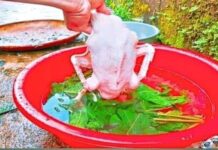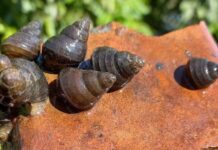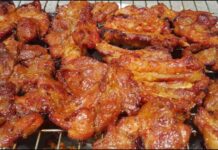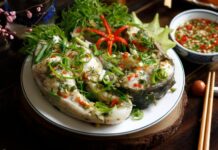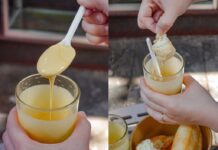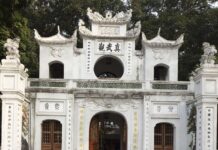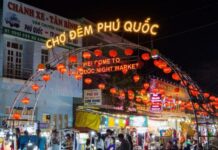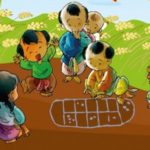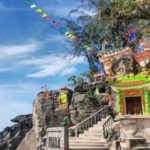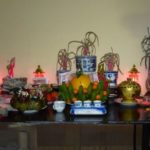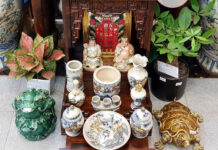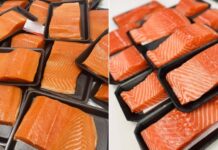In Vietnamese culture and tradition, every province, village, and commune has Dinh, Den, Mieu, and Phu—places of worship for deities and holy mothers. These deities and holy mothers are ancestors who have contributed to the community and the nation in the history of Vietnam’s struggle for independence and nation-building.
Today, upholding the beautiful values of our ancestors, Vietnamese people from all over the country still visit and pay respect at these places of worship on holidays, festivals, and special occasions to express their reverence and gratitude to the deities and holy mothers. Join us to explore the complete and detailed guide to the worship ritual of the Three Holy Mothers in 2024!
Related: The upcoming Tet holiday in 2024 and its details
1 Who are the Three Holy Mothers?
The Three Holy Mothers, or Tam Toa Thanh Mau, are worshipped in most temples, halls, and palaces in the belief of Mother Goddess worship. As the name suggests, the Three Holy Mothers consist of three holy goddesses: the First Upper Heavens, the Second Upper Mountains, and the Third Water Palace.
- The First Upper Heavens or the First Goddess is the goddess who rules the sky and has the power to create rain, wind, and thunder. She governs the Four Laws: the Law of Clouds, the Law of Rain, the Law of Lightning, and the Law of Thunder. The First Goddess is known as Lady Liễu Hạnh, who descended to Earth three times. As the ruler of nature, she greatly contributed to Vietnam’s agriculture and cultivation. Temples dedicated to the First Upper Heavens can be found everywhere, but the largest and most sacred one is where she descended or manifested her presence. The First Goddess is usually seated in the middle of the Three Holy Mothers, dressed in red, and her main festival is held on the 3rd day of the 3rd lunar month every year.
- The Second Upper Mountains or the Second Goddess has the power to govern the mountainous regions and is closely associated with humans, plants, and animals. Therefore, wherever there are mountains, there are temples dedicated to the Second Upper Mountains. Her festival is held on the 20th day of the 9th lunar month annually, and she is depicted sitting on the left side, dressed in green. The Second Goddess is also known by various names, including Diệu Tín Thiền Sư, Lê Mại Đại Vương, Đông Cuông Princess, Lâm Cung Holy Mother, Second Palace Mother, Sơn Tinh Princess, and more.
- The Third Water Palace or the Third Goddess, also known as the Water Goddess, governs the waterways and is closely associated with the aquatic life of the people, both in the past and present. The Third Goddess is usually seated on the right side of the Three Holy Mothers, dressed in white, and her festival is held on the 10th day of the 6th lunar month every year.
 Who are the Three Holy Mothers?
Who are the Three Holy Mothers?
2 The Significance of the Worship Ritual of the Three Holy Mothers
As mentioned earlier, the worship ritual of the Three Holy Mothers is a beautiful spiritual tradition passed down from generation to generation. With sincerity and devotion, people hope that through their acts of worship and prayer, they will receive blessings and protection from the deities and holy mothers, bringing good fortune and success in their lives and careers.
 The Significance of the Worship Ritual of the Three Holy Mothers
The Significance of the Worship Ritual of the Three Holy Mothers
3 How to Prepare Offerings for the Three Holy Mothers
According to traditional customs, when visiting places of worship, one can offer gifts of any size, quantity, or value, depending on their means and intentions. Although these places are dedicated to saints, gods, and holy mothers, it is acceptable to offer vegetarian offerings such as incense, flowers, fruits, and ceremonial cakes.
- Vegetarian Offerings: These include incense, flowers, tea, fruits, and ceremonial cakes, which are used to worship the Buddha and Bodhisattvas (if any). Vegetarian offerings are also suitable for the Three Holy Mothers.
- Non-Vegetarian Offerings: If you believe in offering non-vegetarian food, it is advisable to purchase vegetarian food shaped like chickens, pigs, sausages, or meatballs.
- Live Offerings: It is strictly forbidden to offer live animals such as eggs, rice, salt, or meat at the altars of the Five Tigers, White Snake, and Green Snake in the lower ban of the Public Four Palaces.
- Cỗ Sơn Trang: This includes special Vietnamese vegetarian delicacies, but it is not appropriate to use crab, snail, eel, chili peppers, or lime fruits. If you offer sticky rice, it should be red sticky rice cooked as a dessert.
- Offerings for the Worship of the Young Gods and Goddesses: These usually include ceremonial cakes, fruits, incense, flowers, mirrors, combs, and other small and beautiful toys typically given to children. These offerings are carefully selected and wrapped in small, attractive packages.
- Offerings for the City God and the God of the Fields: It is considered auspicious to offer vegetarian food, and your prayers will be answered.
 How to Prepare Offerings for the Three Holy Mothers
How to Prepare Offerings for the Three Holy Mothers
4 Worship Ritual for the Three Holy Mothers
Nam Mo A Di Da Phat!
Nam Mo A Di Da Phat!
Nam Mo A Di Da Phat! (Bow three times)
– We respectfully bow to the Effectiveness of the Highest Heaven, the Golden Decision of the Jade Emperor, and the High Emperor of the Mysterious Palace.
– We respectfully bow to the Yellow Emperor, the Later Earth, and the Noble Gods.
– We respectfully bow to the Ninefold Azure Clouds and the Six Palaces of the Princesses.
– We respectfully bow to the Goddess of Heavenly Immortal, Quỳnh Hoa Liễu Hạnh Mã Hoàng Princess, the title of Chế Thắng Hòa Diệu Đại Vương, and the title of Tiên Hương Thánh Mẫu.
– We respectfully bow to the Second Highest Peak, the Great King of the Mountain, Lê Mại Đại Vương.
– We respectfully bow to the Fourth Inspector Holy Mother, the Four Attendants, the Five Great Palaces, the Ten Palaces, the Twelve Fairies, the Twelve Holy Boys, the Five Tigers Generals, the Green Emperor, and the White Snake General.
We, the descendants, whose names are: ……………
Residing at: …………….
Today is the …… day of the …… month of the …… year.
We come to the Electric (Palace, Temple, or Den) ……… with our hands clasped in prayer and our heads bowed in reverence. With sincerity and devotion, we respectfully offer our gifts and ask for your compassion and protection for our family’s health, longevity, peace, and prosperity. We pray for success in our endeavors, blessings in our careers, and safety in our lives. We humbly offer our gifts with sincerity and respect.
Nam Mo A Di Da Phat!
Nam Mo A Di Da Phat!
Nam Mo A Di Da Phat! (Bow three times)
 Worship Ritual for the Three Holy Mothers
Worship Ritual for the Three Holy Mothers
5 Notes on Offering Rituals to the Holy Mothers
Offerings to the Holy Mothers can be made on any day of the month or when there is a special need for prayer, without considering auspicious or inauspicious days.
As mentioned earlier, the offerings are just a means of expression, and it is the sincerity and devotion that matter the most. It is absolutely unacceptable to think that offering less will result in the Holy Saints not accepting your prayers.
When visiting temples, halls, or palaces, it is essential to dress appropriately and behave respectfully. If there is a caretaker or guardian at the place of worship, it is polite to ask for permission and greet them before performing the rituals. The same courtesy should be extended when leaving.
Regarding monetary offerings, it is advisable to place the money in the donation box personally and to offer a larger denomination bill, such as 20,000 VND, instead of multiple smaller bills.
 Notes on Offering Rituals to the Holy Mothers
Notes on Offering Rituals to the Holy Mothers
The above information provides a comprehensive guide to the worship ritual of the Three Holy Mothers. Stay tuned for more informative articles from us.











